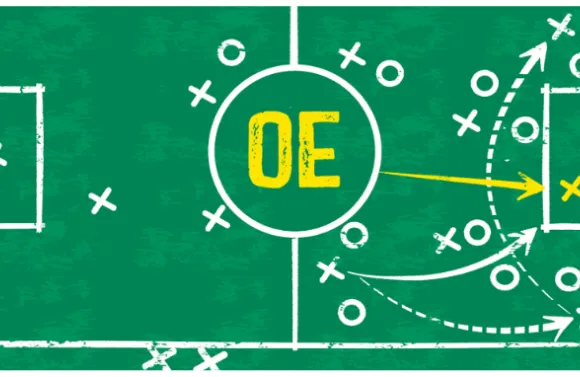
Open enrollment season is approaching—and, in many companies, that means an avalanche of emails about employee benefits. For HR leaders, this is a prime time to communicate with team members about their benefits and help them select the right plans for themselves. But to be strategic, you need to prioritize your open enrollment communications.
With so much happening during open enrollment, you might be tempted to unleash a flood of messages to get your employees’ attention. But a more selective approach will help ensure that employees hear, and act on, your messages. Prioritizing your open enrollment benefits communications can:
- help employees make informed decisions more quickly and easily.
- focus your HR team on what’s important to prevent burnout during a busy period.
- support strategic goals, such as improving participation in your benefits programs.
Let’s walk through why to prioritize open enrollment benefits communications—and how to choose your top two focus areas this upcoming season.
Taking a Targeted Approach to Benefits Communications During Open Enrollment
Why should you streamline your communications approach during open enrollment? Let’s turn to a basic principle of human behavior. Receiving too much information at once can trigger cognitive overload and prevent people from taking action. It’s a classic example of what psychologist Barry Schwartz calls the “paradox of choice.”
Stress researcher Thomas Saltsman and his colleagues tracked people’s cardiovascular responses as they made decisions. Participants who chose from many options “felt more invested in the decision: their hearts beat harder and faster, but their arteries also constricted—a sign that they also felt less confident about their decision,” Saltsman wrote in Fast Company.
“In other words, when we’re presented with more choices, making the “right” or “correct” decision begins to feel more crucial and, at the same time, more unattainable,” Saltsman concluded.
Trying to educate employees on their entire range of benefits within a short timeframe can easily overwhelm them. Adding to the stress, many companies have planned or delayed benefit changes in the works this year. Employees will have critical decisions to make, often requiring deep and timely conversations with their families.
Simplifying your “asks” of employees can help reduce their stress and free up mental bandwidth for these important decisions. This is a tangible way to support your employees’ well-being that can ultimately contribute to retaining top talent.
How to Identify Your “Big Two” Priorities
Identifying your most important benefits-related messages is the first step to making sure they don’t get lost. We recommend choosing two campaigns to promote during open enrollment season to make your benefits communications stick. For example, you might decide to prioritize marketing for two new programs:
- a health insurance plan that offers lower premiums for employees who complete a wellness assessment
- a new flexible spending account (FSA) or health savings account (HSA) available through your company that allows people to save on health-related expenses
Now, let’s explore some key factors to consider as you decide on your two focus areas.
What to Prioritize in Open Enrollment Communications
During open enrollment, consider focusing your efforts on benefits programs that are:
- New or changing: Highlight what’s changing, not what’s staying the same. Build in ample time to announce new programs, educate employees about how they work, perform demos and answer questions.
- Time-sensitive: Urgency is a powerful marketing message, but make it count! Focus on driving action with critical communications for programs with limited enrollment windows. Save the evergreen programs for another spot in your communications calendar after open enrollment.
- Relevant to everyone: New programs that affect most or all of your company’s employees should be high on the priority list.
- In high demand: If you’re delivering a new benefit your team members have been asking for, open enrollment could be a good time to show you’ve been listening. For instance, offering new coverage for employees with chronic conditions could be life-changing for many of your team members.
- Helpful to employees: Don’t miss a chance to promote programs that deliver concrete benefits to team members—such as a tax-advantaged account like an FSA, or a company-sponsored contribution for employees who open a 401(k). Making sure employees aren’t leaving money on the table is a good way to show the company cares about them.
- Good for promoting well-being: Benefits that help employees improve their health and productivity could be a top priority. For example: a wellness program may, or may not, kick off near open enrollment—but maybe it offers something that team members really need, like gym memberships. If that program could save team members on their insurance premiums, it could be even more timely.
- Aligned with business goals: Consider your company’s big-picture financial objectives, and time your communications to support those goals. If a certain benefit will save your company money, open enrollment could be the best time to communicate about it.
If you need help deciding which benefits deserve more attention, you could create a chart of your benefits and which priority categories they are in. You may notice there’s one benefit that checks several important boxes—perhaps it’s new, covers all employees, can only be selected during open enrollment, is something employees have asked for, and has a big impact on their health and wellness. Those are strong indicators you should bump it to the top of your list this year.
What to Deprioritize in Open Enrollment Communications
Giving your open enrollment messages some breathing room can make employees more receptive to hearing other benefits-related messages throughout the year. Here’s what you might want to deprioritize:
- Benefits with low impact or usage: Look at performance metrics and deprioritize benefits that haven’t moved the needle or are less applicable (like free lunches when most staff members are now remote).
- Benefits needed only during key moments: Your company might offer important benefits that are only needed sporadically—like mental health programs offered through employee assistance programs. The good news: Since there’s no time limit on when to enroll in these, you can plan your communications more outside of open enrollment.
- Programs with year-round enrollment: Some benefits programs, like a diabetes management program, can be added throughout the year. You may want to save your marketing firepower for more urgent items.
- Complex benefits programs: When you’re battling the clock, it may not be the best time to launch programs that need a lot of explanation. You may need to build a long communication runway to prepare your employees for adoption. If you must roll out a new benefit program, try leveraging specific communications for employees who would benefit from knowing about this sooner than later.
Breaking through the Noise: Strategies for Successful Open Enrollment Marketing
You’ve landed on the programs that are essential to promote during open enrollment. Now, how to break through the inbox clutter and motivate employees to act?
- Be direct. What do you really want employees to know about their benefits? Highlight those key takeaways in simple, clear language so people can’t miss the meaning. Your main message may be “We’ve listened to you and are introducing the right benefits for you.”
- Lead with impact. Employees don’t have the time or desire to read between the lines. Grab their attention by driving straight to the impact on their daily lives. Your campaign headline might be something like, “You could save $1,200 if you switch to this new plan.” These kinds of targeted messages could be created by your decision support vendor based on individual claims.
- Repeat yourself. It takes seven times of hearing the same message before someone buys, according to the classic marketing statistic. The same is true in benefits communications. Repeat your core messages again and again, until you see results.
- Use progressive disclosure. With this technique, you give employees just enough information to take the next step, so they don’t get overwhelmed by details they don’t need yet. Create easily digestible one-pagers or emails with key points. Save the comprehensive information for an online hub or benefits guide for employees who want to dig deeper.
- Segment your audiences. Categorizing your team members by factors like age and stage of life can help you create much more relevant messages. It’s the difference between: “Learn which expenses your HSA card can pay for” and “Learn how your HSA card can pay for your kids’ braces, glasses, and more!” You can also use a third-party to segment your audience based on historical claims and usage for more targeted and helpful messages.
- Be clear and use a variety of headlines for each key message to get employees’ attention.
- Try different formats. Sometimes people need to hear messages in different formats for them to “click.” Try using a mix of channels, like email, webinar, direct mail, intranet and video.
Creating an Effective Benefits Communications Calendar
You can solidify your strategy with an annual calendar that builds in time to educate employees about new programs and benefits changes. For instance, if you’re rolling out a high-deductible health plan, you may need time to explain the tax advantages and lower premiums involved in these plans. Learn how to trickle out your benefits communications before, during and after open enrollment season.
Here’s a sample calendar for the weeks leading up to open enrollment (OE):
- 12 weeks before OE: Send out an email teaser if you have early information about the top benefits that you’re promoting this year.
- 8 weeks before OE: Share more information about OE and this year’s top focus areas, including OE dates. Send a save-the-date postcard and calendar invitation to keep OE top of mind with employees.
- 6 weeks before OE: Make sure your top messages are highlighted in your benefits portal, benefits guides and in your FAQs. Train managers on the OE areas of focus, so they can help field employee questions.
- 4 weeks before OE: Showcase your top priorities in a short video and include it in your decision support tool. If a new health plan is key to your strategy, use the tool to help employees choose the best plan for their needs.
- 2 weeks before OE: Remind employees about OE dates and how important the top focus areas are. Link to the intranet, plan documents, tools and other resources to help support those who want more details. If getting employees into the right health plans is a key priority, send a precheck email or direct mail highlighting how much money they could save if they chose the right plan based on their previous year’s costs and plan
- OE launch: Remind employees about OE and the top two to three things they should know.
- During OE: Track and monitor enrollment statistics to assess whether your message is getting through. Experiment with different subject lines to grab employees’ attention.
- After OE: Analyze your success and survey your employees about their experience to start planning for next year. This can help you start defining your new benefits priorities.
Getting the Most out of Open Enrollment Season
Open enrollment season is a great opportunity to get people on the right track with their benefits programs—and drive home the benefits offered by new options. While many employees may want to choose the same thing every year, you can help them understand when a new plan could save them money, offer larger provider networks or simply feel better by managing troublesome health conditions.
Decision support tools can take the guesswork out of these discussions and empower employees to make a suitable choice. Nine out of 10 employees would be likely to use a free online program offering benefit advice, according to the EBRI/Greenwald Research Workplace Wellness Survey.
Benefitfocus offers a benefits decision support platform that walks your employees through a personalized health plan recommendation based on their needs. Plus, it only takes about three minutes. To learn more and see it for yourself, request a demo today.


